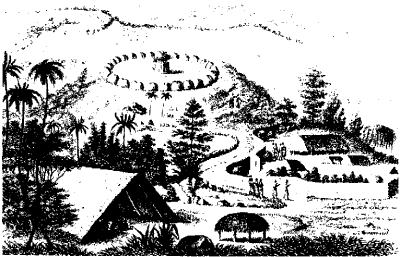 |
Science Frontiers ONLINE No. 120: Nov-Dec 1998 |
|
|
The Pigeon-snaring Mounds Of Tonga
In North America, the industrious Mound-builders excavated untold millions of basketfuls of soil which they piled up in impressive mounds. Flat-topped Monk's Mound at Cahokia, Illinois, rivals the Great Pyramid in volume. A casual observer of this huge earthen structure could only conclude that such immense labor was undertaken for some social imperative, such as worship or sacrifice. Perhaps this was the case in North America, but deep in the South Pacific, just east of Fiji, on the islands of Tonga, native peoples scraped large mounds of earth for what seems to be a frivolous purpose: pigeon-snaring!
But bear in mind that carnivory on these romantic Pacific islands was difficult because large game animals were nonexistent. Captured enemies helped solve the protein problem, but pigeons were much more common, and some species were good-sized and delicious. So much so that eventually only island royalty was allowed to catch and eat them. Pigeon poachers were whipped or executed (and maybe eaten?) In fact, pigeon snaring became a royal sport. To this end, starting at least a thousand years ago, the king's loyal subjects grubbed up the thin island soil and piled it up into high mounds.
Tonga's pigeon-snaring mounds did not compete with Monk's Mound sizewise, being at most 115 feet in diameter and perhaps 15 feet high. But that's still a lot of dirt. On the tops of the mounds were smaller, beehive-shaped mounds with vertical slits in them large enough to conceal a human. From these blinds, the king and princes would swing nets on the ends of 12-foot poles to catch pigeons.
Of course, no self-respecting wild pigeon would ever fly over such a suspicious hill without some enticements. So, captive pigeons caged on the mound were set to cooing and other pigeons tethered by long strings were launched. Sure enough, wild pigeons were lured close enough to be snared.
(Burley, David V.; "Sport, Status, and Field Monuments in the Polynesian Chiefdom of Tonga: The Pigeon Snaring Mounds of Ha'apai," Journal of Field Archaeology, 25:421, 1996.)
Comment. Now let's see, in the heyday of the Moundbuilders, the North American skies were darkened by flocks of Passenger Pigeons. Hmmm!
 \ \ | A 1893 sketch of a pigeon-snaring mound on Tongatapu. The pigeon snarers hid in the slits seen in the circle of small behive mounds atop the main mound. |